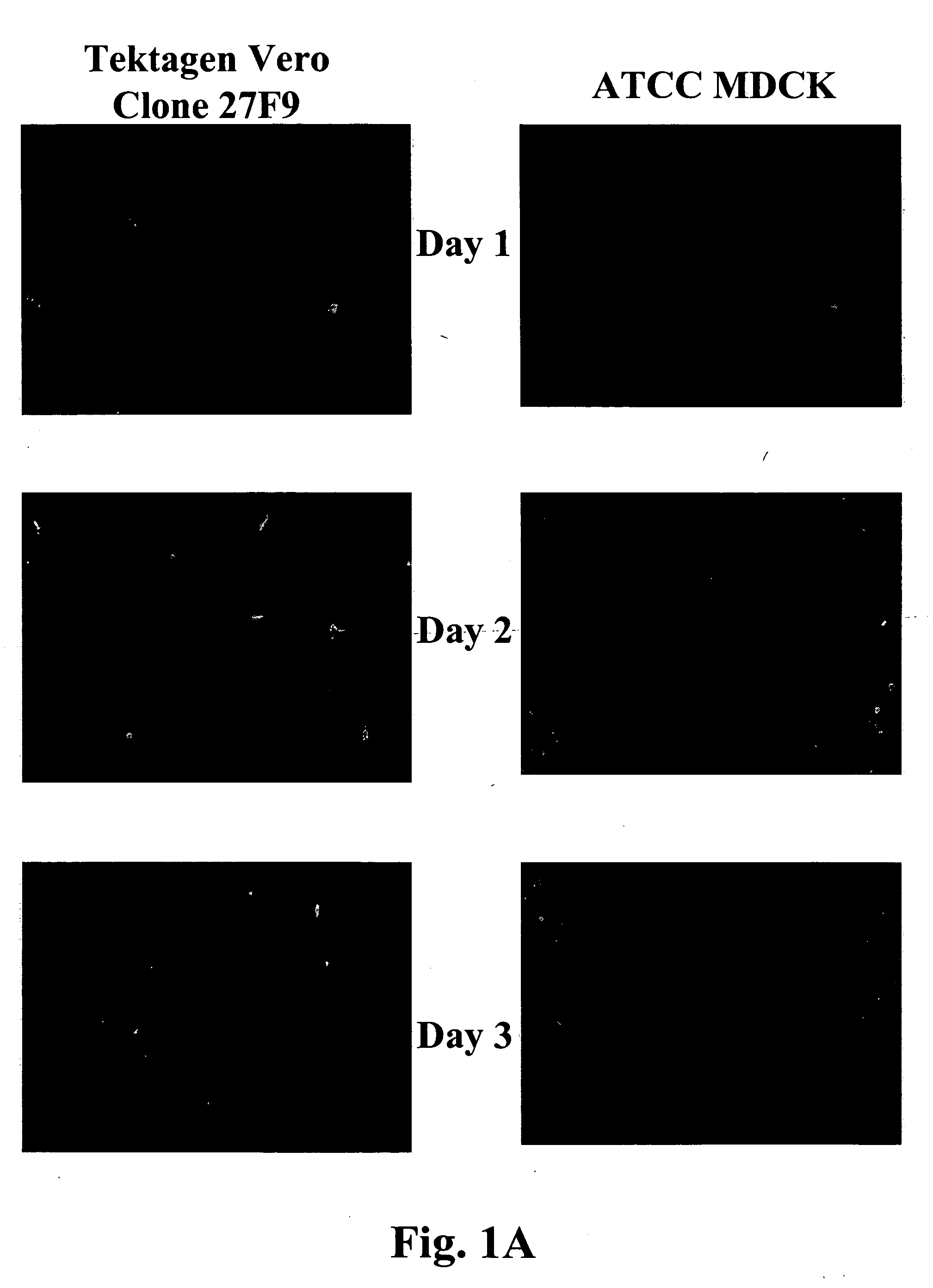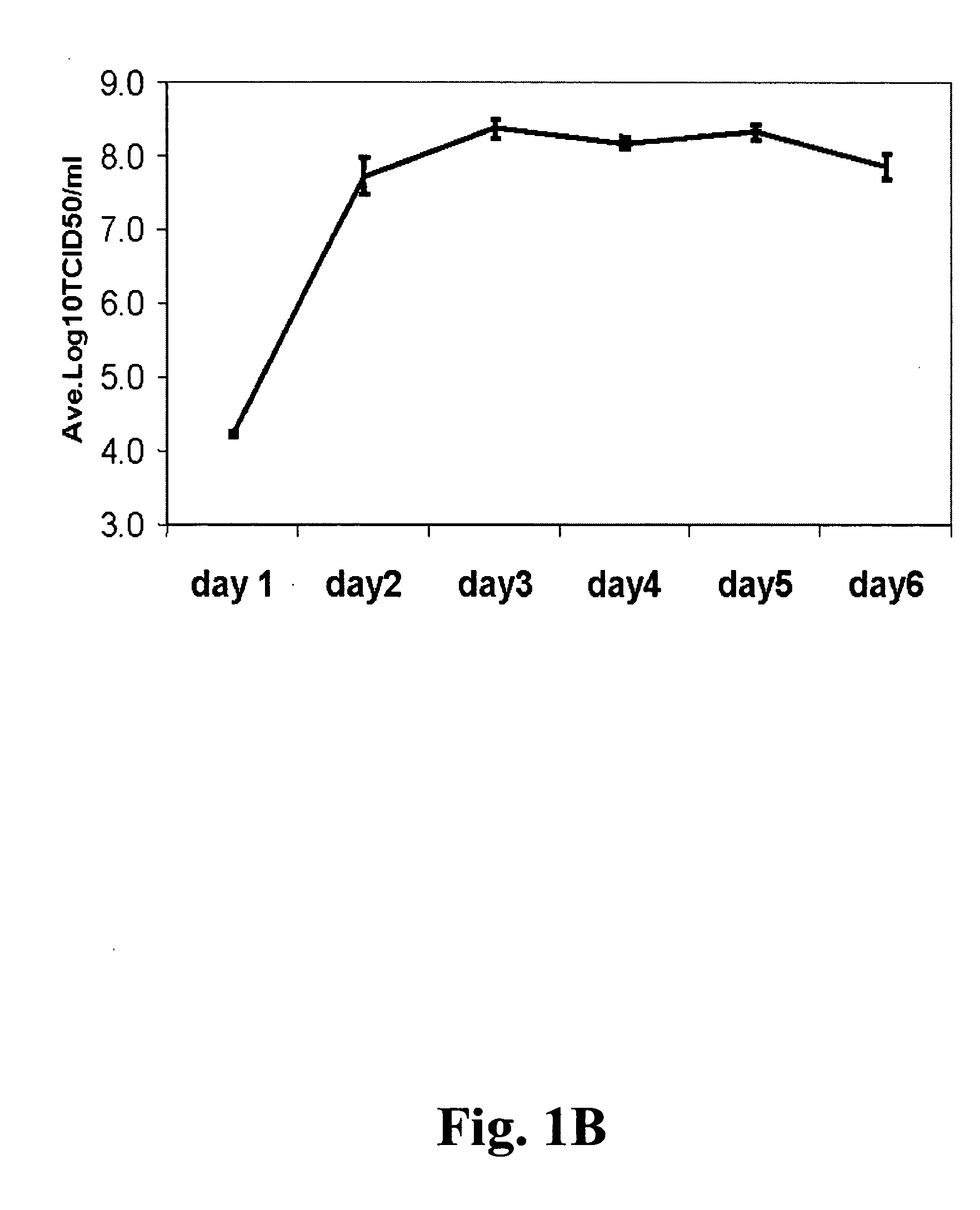Non-tumorigenic MDCK cell line for propagating viruses
- Summary
- Abstract
- Description
- Claims
- Application Information
AI Technical Summary
Benefits of technology
Problems solved by technology
Method used
Image
Examples
example 1
Determination of Spread of Infection of ca / ts Influenza Strains in Cell Lines and Characterization of Influenza Produced in MDCK Cells
[0102] There has been an effort by the vaccine industry to develop alternative production platforms that do not utilize eggs and to produce influenza vaccines in a mammalian or insect cell culture system. The obvious advantages are easy scalability, increased process control and removal of egg proteins that could cause allergic reaction in some vaccines. Since cell culture based systems can be rapidly scaled up, it offers an additional advantage at the time of a influenza pandemic, when there is a potential for shortage of supply of eggs and rapid production of vaccine is required. Initial studies have been performed with a total of 7 different cell lines: 2 human diploid lung fibroblast lines (MRC-5 and WI-38) (data not shown), a human retinoblastoma and a human kidney cell line both of which were genetically constructed for production of adenovira...
example 2
Derivation of Non-Tumorigenic Serum MDCK Cells
[0108] MDCK cells have been traditionally used for the titration of influenza viruses (Zambon, 1988, in Textbook of Influenza, ed Nicholson, Webster and Hay, ch 24, pg 324-332, Blackwell Science) and thus could be used for the propagation of influenza for the production of vaccine materials. However, MDCK cells have traditionally been grown in basal medium formulations like Eagle's Minimal Essential Medium (EMEM) supplemented with FBS. Multiple reports indicate that MDCK cells may be tumorigenic when cultivated under these conditions and / or for extended periods of time (see for example, Gaush et al., Proc Soc Exp Biol Med, 122:931; Leighton et al., 1968, Science, 163:472 and Leighton et al., 1970, Cancer, 26:1022). Thus, there is concern about the use of MDCK cells for the production of vaccine materials and efforts have focused on the development of other cell lines (e.g., PER.C6 and VERO). Unfortunately, not all influenza strains gro...
example 3
Derivation of Serum-Free MDCK Cells in Taub's Media
[0137] The results detailed Example 2 above demonstrate that MDCK cells can be cultivated under conditions that maintain their epithelial morphology and normal karyology as well as their ability to replicate cold adapted influenza strains. In addition, we demonstrated that cultivation of MDCK cells under the conditions developed in the above study results in MDCK cells that are non-tumorigenic. However, the culture medium used in Example 2 contains fetal bovine serum (FBS). FBS is a complex mixture of constituents and there have been problems reported of lot-to-lot variation. Also, the ongoing problems with bovine spongiform encephalopathy (BSE) in cows raise safety concerns. The development of serum-free medium in which the non-tumorigenic nature and growth characteristics of the MDCK-S cell line is maintained is important for increasing the safety of biologicals produced for therapy and vaccination.
[0138] Madin Darby Canine Kid...
PUM
| Property | Measurement | Unit |
|---|---|---|
| Volume | aaaaa | aaaaa |
| Volume | aaaaa | aaaaa |
| Volume | aaaaa | aaaaa |
Abstract
Description
Claims
Application Information
 Login to View More
Login to View More - R&D
- Intellectual Property
- Life Sciences
- Materials
- Tech Scout
- Unparalleled Data Quality
- Higher Quality Content
- 60% Fewer Hallucinations
Browse by: Latest US Patents, China's latest patents, Technical Efficacy Thesaurus, Application Domain, Technology Topic, Popular Technical Reports.
© 2025 PatSnap. All rights reserved.Legal|Privacy policy|Modern Slavery Act Transparency Statement|Sitemap|About US| Contact US: help@patsnap.com



